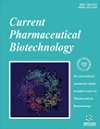- Home
- A-Z Publications
- Current Pharmaceutical Biotechnology
- Previous Issues
- Volume 23, Issue 12, 2022
Current Pharmaceutical Biotechnology - Volume 23, Issue 12, 2022
Volume 23, Issue 12, 2022
-
-
Nanoengineered Therapeutic Scaffolds for Burn Wound Management
More LessAuthors: Ziauddin, Tanveer Hussain, Ahsan Nazir, Urwa Mahmood, Misbah Hameed, Seeram Ramakrishna and Sharjeel AbidBackground: Wound healing is a complex process, and selecting an appropriate treatment is crucial and varies from one wound to another. Among injuries, burn wounds are more challenging to treat. Different dressings and scaffolds come into play when skin is injured. These scaffolds provide the optimum environment for wound healing. With the advancements in nanoengineering, scaffolds have been engineered to improve w Read More
-
-
-
Medicinal Herbs from Phytoinformatics: An Aid for Skin Burn Management
More LessAuthors: Deepti Sharma, Sapna Jain, Amit K. Mishra, Ruby Sharma and Ankit TanwarSkin burn injury is the most common cause of trauma that is still considered a dreadful condition in healthcare emergencies around the globe. Due to the availability of a variety of regimes, their management remains a dynamical challenge for the entire medical and paramedical community. Indeed, skin burn injuries are accompanied by a series of several devastating events that lead to sepsis and multiple organ dysfunction s Read More
-
-
-
Lipid Engineered Nanoparticle Therapy for Burn Wound Treatment
More LessAuthors: Abdul Qadir, Usama Ahmad, Asad Ali, Aisha Shahid, Mohd. Aqil, Nausheen Khan, Athar Ali, Waleed H. Almalki, Saad Alghamdi, Md. A. Barkat and Sarwar BegIntroduction: Skin is the largest organ of the human body protecting the underlying organs and tissues from any foreign attack. Any damage caused in the skin may sometimes result in serious consequences within the internal body tissues. Burn is one such issue that damages the layers of the skin and thereby making the skin vulnerable and prone to any foreign matter entering and causing serious diseases. Methods: An Read More
-
-
-
Polymer-based Nanotherapeutics for Burn Wounds
More LessAuthors: Rewati R. Ujjwal, Awesh Yadav, Shourya Tripathi and S.T.V. Sai KrishnaBurn wounds are complex and intricate injuries that have become a common cause of trauma leading to significant mortality and morbidity every year. Dressings are applied to burn wounds with the aim of promoting wound healing, preventing burn infection and restoring skin function. The dressing protects the injury and contributes to recovery of dermal and epidermal tissues. Polymer-based nanotherapeutics are increasin Read More
-
-
-
Carbon-based Nanomaterials: Carbon Nanotubes, Graphene, and Fullerenes for the Control of Burn Infections and Wound Healing
More LessAuthors: Mohammad A. Rahman, Harshita Abul Barkat, Ranjit K. Harwansh and Rohitas DeshmukhBurn injuries are extremely debilitating, resulting in high morbidity and mortality rates around the world. The risk of infection escalates in correlation with impairment of skin integrity, creating a barrier to healing and possibly leading to sepsis. With its numerous advantages over traditional treatment methods, nanomaterial-based wound healing has an immense capability of treating and preventing wound infectio Read More
-
-
-
Antifungal Biofilm Strategies: A Less Explored Area in Wound Management
More LessAuthors: Shilpa Bharti, Foziyah Zakir, Mohd A. Mirza and Geeta AggarwalBackground: The treatment of wound-associated infections has always remained a challenge for clinicians, with the major deterring factor being microbial biofilms, majorly bacterial or fungal. Biofilm infections are becoming a global concern owing to resistance to antimicrobials. Various fungal pathogens form fungal biofilms, namely Candida sp., Aspergillus fumigates, Trichosporon sp., Saccharomyces cerevisiae, Cryptoc Read More
-
-
-
Biocompatible Nanomaterials for Burns
More LessAuthors: Mayank Handa, Sandeep K. Maharana, Kamlesh Pal and Rahul ShuklaThe skin being the largest organ, protects our body against harmful chemicals, pathogens, and physical agents. It constitutes primarily three layers: epidermis, dermis, and subcutaneous layers. Injuries occurring due to burning remain localized to the skin or other organic tissues caused by flame, extreme heat, and close contact with chemicals or heated objects. Conventional treatments are available for the treatment of burns; ho Read More
-
Volumes & issues
-
Volume 26 (2025)
-
Volume 25 (2024)
-
Volume 24 (2023)
-
Volume 23 (2022)
-
Volume 22 (2021)
-
Volume 21 (2020)
-
Volume 20 (2019)
-
Volume 19 (2018)
-
Volume 18 (2017)
-
Volume 17 (2016)
-
Volume 16 (2015)
-
Volume 15 (2014)
-
Volume 14 (2013)
-
Volume 13 (2012)
-
Volume 12 (2011)
-
Volume 11 (2010)
-
Volume 10 (2009)
-
Volume 9 (2008)
-
Volume 8 (2007)
-
Volume 7 (2006)
-
Volume 6 (2005)
-
Volume 5 (2004)
-
Volume 4 (2003)
-
Volume 3 (2002)
-
Volume 2 (2001)
-
Volume 1 (2000)
Most Read This Month
Article
content/journals/cpb
Journal
10
5
false
en


